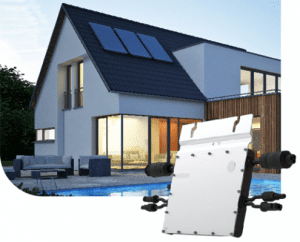How Does a Microinverter Convert From a DC to an AC Power Supply?
So, you’ve read up on the financial and environmental benefits of solar power AC and decided to invest in a solar installation. At this point, you’ll need to start researching the two essential components of any solar power system: the solar panel and the inverter.
But what does an inverter actually do? Why are they so important? What’s the difference between an inverter and a microinverter? And what kind of inverter should you choose for your installation? We’ve pulled together all of the most important information you need to know about inverters, solar panels and energy currents – jargon-free – below.
WHAT IS AN INVERTER? HOW IS IT DIFFERENT FROM A MICROINVERTER?
Inverters are needed because the energy produced by solar panels – direct current (or DC) energy – can’t be used by most home electronics. DC to AC power inverters turn that DC power into alternating current (AC) power, so it can be channeled into a building’s outlets safely.
Traditional ‘string’ inverters connect to multiple solar panels in series, taking in all of the DC power they produce and converting it as one big chunk of energy. Microinverters, on the other hand, are smaller and convert energy from each panel independently. This means they’re usually more reliable since, if one solar panel fails, power can still be converted from all of the other panels.
WHAT IS DIRECT CURRENT POWER?
To understand how DC to AC inverters work, you first need to understand the difference between direct current (DC) energy and alternating current (AC).
When we talk about DC and AC energy, we’re talking about the direction in which energy moves.
In a direct current, electrons only flow in one direction. DC energy is a little more stable than AC energy, so it’s often used in situations where energy needs to be stored for future use – the batteries in your remote control, for example.
Next, let’s establish how solar panels work.
In solar panels, DC energy is generated when photons (light particles) displace the electrons from the silicon atoms you find in solar panels in a process called the ‘photovoltaic effect’. Metal plates on the sides of each silicon ‘cell’ in a solar panel then transfer these displaced electrons into wires, where they can flow through a microinverter and into a building (or onto the grid).
So, if direct current energy is more stable and is produced by solar panels, why do we need microinverters to convert it to AC energy?
WHAT IS ALTERNATING CURRENT POWER?
Alternating current energy is less stable than direct current energy. The flow of electrons in an alternating current changes direction periodically, meaning that the voltage of the current also changes at regular intervals.
All of the outlets in your home run on alternating current energy. Why? Because direct current energy is much harder to transport over long distances; if you tried to pipe DC electricity from a power station to homes, offices, or public buildings, most of it would be lost along the way.
Alternating current energy, on the other hand, is much easier to transport over a national grid. As a result, you’ll rarely find a building that doesn’t run on an AC current.
Here is a summary of the differences between the two types of current:
| Alternating current (AC) | Direct current (DC) | |
| Electron flow | Changes direction periodically | Stable in one direction |
| Voltage polarity | Changes periodically | Stays the same |
| Used in | Outlets, anything that requires long-distance power transmission | Batteries, electronics, solar panels |
HOW DOES A MICROINVERTER CONVERT DC TO AC ELECTRICITY?
As we outlined above, the energy generated by your solar panel is direct current. This means the energy can be stored easily, but it’s not compatible with the power outlets in most buildings.
This is where the microinverter comes in. When a solar panel transmits energy into a microinverter, DC to AC inverters work by transmitting the energy back and forth rapidly through a transformer, placed between two transistors. In doing so, the microinverter forces the energy to switch directions constantly – in short, creating an alternating current.
Because this alternating current is created ‘artificially’, it’s usually a little less smooth than the AC that’s created by a generator, for example. To fix this, the inverter will then use several filters to ‘clean up’ the current so it changes direction in a more consistent pattern, making it suitable for use in a building’s power outlets.
Microinverters are also known for their maximum power point tracking or MPPT. This function determines how much DC energy a solar panel is capable of generating at any given moment, and then optimizes the performance of the panel so that it generates as much power as possible.
WHY ARE MICROINVERTERS SO IMPORTANT?
A good quality microinverter is vital for turning the energy absorbed by your solar panels into safe, usable electricity. If your microinverter fails, you can’t get any energy from the associated solar panel, so it’s important to think carefully about which vendor can provide the best, most reliable service.
Most importantly, a good microinverter will transform this energy from DC to AC as efficiently as possible, minimizing the amount of power that’s lost in the process and maximizing the output of your solar energy system. Many microinverters can also help you to closely monitor the performance of your solar installation, so they’re also often used to anticipate any issues and find ways to maximize power output.
If you’re making the switch to solar energy, pay close attention to your microinverters; they may not be as visible as your solar panels, but they’re absolutely essential.




